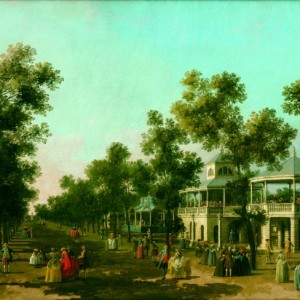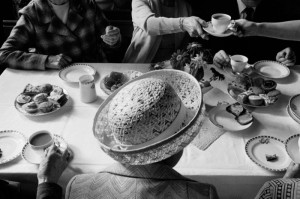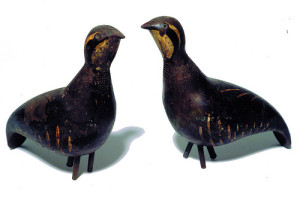A Compton Verney Day
“Radio check….Steve….over”
“Steve receiving….out”
And with that I’m flying solo; my first duty as a Gallery Assistant at Compton Verney. Here I stand; comfortable shoes, irrepressible smile, a barely discernible hint of adrenalin, and Canaletto for company.
 And oh what company. I’ve often felt that secret resentment, that desire to stand alone in galleries. It’s a perverse rationale that dictates visual pleasure should be a primarily solitary experience. It’s a wholly selfish impulse that strives to protect private indulgence at the expense of the enjoyment of others. Yet as I stand, watching, listening, I feel the heady transition from observer to participant; an irresistible participant in the human emotion of shared experience.
And oh what company. I’ve often felt that secret resentment, that desire to stand alone in galleries. It’s a perverse rationale that dictates visual pleasure should be a primarily solitary experience. It’s a wholly selfish impulse that strives to protect private indulgence at the expense of the enjoyment of others. Yet as I stand, watching, listening, I feel the heady transition from observer to participant; an irresistible participant in the human emotion of shared experience.
There’s a tangible energy at play here, a synaptic spark of wonder, incredulity, humour even. And whatever the personal response to these pictures, be it unalloyed delight, or incompatibility of personal taste, reactions are provoked nonetheless, and infuse the rooms with a collective engagement.
And the beauty of that engagement, the heart-warming humanity of it, is our desire to share. Friend talks to friend, child to parent; gestures beckon, seeking a shared response; fingers point, and hands mimic the graceful rhythm of brushstroke, wave and cloud. The forensic examiner of minutiae rubs welcome shoulders with the lover of the grand effect, the “step back” appreciator of the grander view.
And inevitably that humanity, that subconscious desire to share a welcome experience, percolates up, and breaks the surface. Here it is, the reason why we do this, the payback we each desire; the shared confidence, the irrepressible passion, the search for a deeper meaning, a desire to get closer to the curious genesis of a work of art. The visitor’s question, comment, or conversation is a marvellous litmus test of their reaction to, and engagement with, the works on display. And what insights we get into that engagement; what wonderful opportunities to unlock for a moment an understanding, a memory, a snap-shot of empathy or stimulation.
 As I move on from the Canaletto exhibition rooms to the gloriously evocative exhibition of Martin Parr’s photographs, I become conscious of a beguiling mix of emotions stirred. True, there’s much humour here; this exhibition, like no other, provokes the most smiles; each with its own reason, born of fond memory, perceived incongruities, or self-conscious recognition of shared human experience. But there’s melancholy here too. A deep-rooted sadness for the passing of “simpler” times, for lives lived at a steadier pace. But is that really true? Is there not private stress and shared frustration at play here? If the eye truly is the window to the soul, then the camera lens exposes here its manifest shades and colours; each in turn provoking thoughts of longings and yearnings, frustrations and delights. And so, through these compellingly evocative images comes an unexpected re-evaluation of our own humanity, a brief and unexpected moment of self examination.
As I move on from the Canaletto exhibition rooms to the gloriously evocative exhibition of Martin Parr’s photographs, I become conscious of a beguiling mix of emotions stirred. True, there’s much humour here; this exhibition, like no other, provokes the most smiles; each with its own reason, born of fond memory, perceived incongruities, or self-conscious recognition of shared human experience. But there’s melancholy here too. A deep-rooted sadness for the passing of “simpler” times, for lives lived at a steadier pace. But is that really true? Is there not private stress and shared frustration at play here? If the eye truly is the window to the soul, then the camera lens exposes here its manifest shades and colours; each in turn provoking thoughts of longings and yearnings, frustrations and delights. And so, through these compellingly evocative images comes an unexpected re-evaluation of our own humanity, a brief and unexpected moment of self examination.
One lady confides in me that she can’t look at these images without feeling sad, and turns to leave. I urge her to take a fresh look, to see the humour alongside the pathos. She tries briefly, then succumbs to the melancholy once more, and makes back to the Canaletto exhibition in search of his little dog; a vital antidote, she says, to her present mood. We part with a laugh.
 In the Folk Art gallery I come across a man stooped over two wooden partridges, blowing for all his worth. His partner looks slightly embarrassed I’ve caught him in the act.
In the Folk Art gallery I come across a man stooped over two wooden partridges, blowing for all his worth. His partner looks slightly embarrassed I’ve caught him in the act.
“Trying to make them whistle” he says, and grins broadly. And that’s what they are for, lovingly fashioned to capture the wind, tangible representations of the partridge’s voice. We speculate on the true nature of their call, and again part laughing; the joy of this place.
Up the steps and into the Folk Art paintings gallery, and here another lady longs to share with me her delight in the curious geometry and proportion of a particularly square sheep. More laughter, and then a welcome discussion on the particularly personal insight these untrained artists bring to their work; a vivacity and vitality often lost on the more “academic” artists. She goes her way with welcome comments on the accessibility of the collection. She goes her way with a smile; a vital connection forged.
As my day comes to a close I make my way down through the galleries, musing on a wonderful insight from a school child, written in the Martin Parr comments book. The beauty of the photographs struck a chord it would seem, and stimulated in him or her a greater understanding of what it was like to live in “the olden times”. The late nineteen seventies, the time of my teenage! I can’t help but smile as I descend the stairs; contemplating my state as living embodiment of those olden times.
My way back to the staff room takes me through the gallery shop, and there at the counter is the lady I met in Martin Parr.
“I found the little dog” she says, a broad grin on her face. “But thank you for making me look at the photographs”.
“My pleasure” I say, “but I’m pleased you found the dog. We wouldn’t want you going home feeling sad”.
One more laugh, and the day comes to a close. One more laugh, one more happy engagement. What more could we wish for?
Images: All images are courtesy and copyright of Compton Verney.
